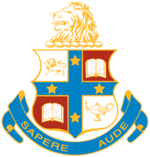Wesley College (Victoria)
| Wesley College | |
|---|---|
|
Dare To Be Wise | |
| Location | |
|
St Kilda Road, Glen Waverley & Elsternwick, Victoria Australia | |
| Coordinates | 37°50′57″S 144°58′55″E / 37.84917°S 144.98194°ECoordinates: 37°50′57″S 144°58′55″E / 37.84917°S 144.98194°E |
| Information | |
| Type | Independent, Co-educational |
| Denomination | Uniting Church |
| Established | 18 January 1866[1] |
| Principal | Dr Helen Drennen |
| Staff | 564 (full-time) |
| Enrolment | 3,100 (K–12)[2] |
| Colour(s) | Purple and Gold |
| Slogan | A True Education (2010 – Present) |
| Website | www.wesleycollege.net |
Wesley College, Melbourne is an independent, co-educational, Christian day school and boarding school in Melbourne, Australia. Established in 1866,[3] the college is a school of the Uniting Church in Australia. Wesley is the largest school in Australia by enrolment, with 3,100 students[2] and 564 full-time staff.[4] The College consists of three main metropolitan campuses, a residential campus, and three outdoor education campuses.
Wesley is a founding member of the Associated Public Schools of Victoria and is affiliated with the Junior School Heads Association of Australia, the Association of Independent Schools of Victoria, the Association of Heads of Independent Schools of Australia and the Headmasters' and Headmistresses' Conference.[5]
In 2010 The Age reported that Wesley College ranked equal tenth among Australian schools, based on the number of alumni who had received a top Order of Australia honour.[6]
Overview and Structure
Wesley College has three metropolitan day campuses: Prahran (renamed St Kilda Road campus from 2004), Glen Waverley, and Elsternwick. At each campus there is an early childhood learning centre which caters for children from ages three to four. There is also a residential learning campus at Clunes and a campus on Guildford Lane, Melbourne, where the city curriculum project is based for Year 9 students. The college owns and operates three outdoor education campuses (camp sites) in Victoria, near Paynesville, Healesville and Portland.[7]
The school was the first registered school in Australia,[8] and operates in a three mini-school structure (Junior, Middle & Senior Schools), which caters for students from kindergarten through to Year 12. In the Junior Schools (3 Year olds to Year 4), students from the Early Childhood Learning Centre to Year 4 are taught within the framework of the International Baccalaureate Primary Years Programme. In the Senior Schools (Years 10 to 12), Wesley offers the Victorian Certificate of Education, International Baccalaureate Diploma Programme, Vocational Education and Training Programme and the Victorian Certificate of Applied Learning Programme.[8]
Wesley enrolment is not subject to entrance examinations or other requirements[9] although some preference is given to female students in order to achieve gender balance.[10] A report in November 2007 cited Wesley's fees as among the highest of any school in Victoria.[11]
History
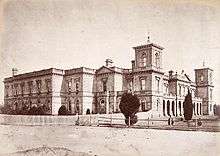
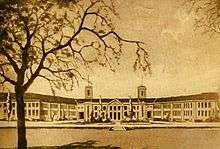
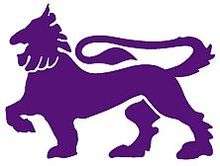
The beginnings of Wesley College came from a decision of the colonial government of Victoria in the wake of the Victorian gold rush to grant land and funds to four religious groups, including the Wesleyan Methodist Church, for the purpose of establishing colleges in Melbourne.[12] In 1854, the government offered the Wesleyans 10 acres (40,000 m2) facing St Kilda Road.[13] Major benefactor Walter Powell encouraged other Wesleyan Methodists to bridge the gap in funds between the government grant and that required to build the school. Daniel Draper and others subsequently contributed sufficient funds. The foundation stone was laid at the present site of the St Kilda Road campus on 4 January 1865. Draper drowned at sea on the day of the school's official opening on 11 January 1866.[3]
James Waugh was chairman of the school committee[14] from foundation until 1883. Dr James Corrigan was the first of seven Headmasters in Wesley's first 35 years. The school struggled for numbers over some of this period. The Depression of the 1890s provided a particular challenge when Arthur Way was Headmaster, and came to a head in 1896 under Arthur Stephenson when enrolment dropped to 90 boys and closure was threatened.[15] Thomas Palmer's tenure as headmaster was curtailed early in 1902 after he was found to have embezzled more than £1,000 of the school's funds.[16]
The colours purple and gold were first chosen when the school was established in 1866. In 1875, they were changed to light blue and white (after Cambridge University and University of Melbourne),[17] but reverted to purple and gold in 1902.
Lawrence Adamson is generally regarded as the single most important figure in the school's history.[18] Adamson was Headmaster from 1902 to 1932 after beginning his teaching career there in 1887. His influence on Wesley survived well into the latter part of the 20th century from staff who were either appointed or were students during his tenure. A recent history of the school defined his contribution as giving Wesley "prosperity, direction and reputation".[19] He personally contributed thousands of pounds of his personal fortune to the school. Adamson was considered less effective in his last decade as headmaster, with the centenary history published in 1967[20] providing the first overt criticism of him.[18]
The St Kilda Road campus was substantially rebuilt and expanded between 1933 and 1939 following a bequest from philanthropists Alfred and George Nicholas.[21] The gift of around £200,000 ($16 million in 2008)[22] funded twin double-storey buildings, science laboratories, a Junior School building, swimming pool, gymnasium, chapel and other facilities.[23] In 1942 the Australian Government requisitioned the school's campus for the Australian Army,[24] resulting in Wesley being accommodated at Scotch College from 1942 to 1943. The college was running out of space at St Kilda Rd and as early as 1937 had secured an option to purchase the land and buildings of Box Hill Grammar School (now Kingswood College).[25] Headmaster Neil MacNeil advanced this option, opening negotiations in 1946.[26] Commercial agreement was reached in 1947 following McNeil's death in office but was never acted on and finally abandoned in 1955.[27]
Thomas Coates (1957–1971) and David Prest (1972–1991) were long-serving headmasters during a period of substantial change, particularly during Prest's tenure. The school purchased land at Syndal in 1955, and for the next few years considered selling the St Kilda Rd campus to fund building at its new location.[28] However, by 1959 it had decided to retain its St Kilda Road location, move the Junior School and establish playing fields at Syndal. Following a period of fund-raising, the new campus (renamed Glen Waverley campus in 1978) opened in 1966.[29]
The school opened enrolment to girls in 1978. Boarding was discontinued in 1980, in order to accommodate more students at St Kilda Road. Wesley first approached Cato College, Elsternwick in the late 1970s regarding amalgamation. Struggling financially, Cato agreed to this in 1986, with integration into Wesley completed by 1989.[30] In November 1989, a fire substantially damaged the St Kilda Road campus. Significant archival material was lost with the virtual destruction of the school library. The damaged areas were rebuilt by 1991.[31]
Historian Andrew Lemon characterised Glen McArthur's tenure as headmaster (1992–1996) as leaving a sense of "unease".[32] With the two larger campuses becoming more autonomous and competitive, McArthur was encouraged by the school council to engender a greater sense of a single school, but in doing so he challenged the positions of both campus heads, who left during his tenure.[33] Ill-health affected McArthur's incumbency, and he died in 1998. David Loader became principal of Wesley in 1997 after 18 years as head of Methodist Ladies' College, Melbourne and brought to fruition the country-based year 9 learning campus at Clunes in 2000.[34] Former Glen Waverley campus head Helen Drennen became Wesley College's first female principal in June 2003.[35]
In April 2016, a fire at the Glen Waverley campus destroyed ten classrooms.[36]
Headmasters and principals
| Years | Name[37] | Years | Name |
|---|---|---|---|
| 1866–1870 | Dr James Corrigan | 1933–1939 | Mr Harold Stewart |
| 1871–1875 | Dr Martin Irving | 1940–1946 | Mr Neil McNeil |
| 1876–1881 | Prof Henry Andrew | 1947–1956 | Prof Wilfred Frederick |
| 1882–1892 | Dr Arthur Way | 1957–1971 | Dr Thomas Coates |
| 1893–1895 | Frank Goldstraw | 1972–1991 | Mr David Prest |
| 1896–1897 | Rev Arthur Stephenson | 1992–1996 | Mr Glen McArthur |
| 1898–1901 | Mr Thomas Palmer | 1997–2002 | Mr David Loader |
| 1902–1932 | Mr Lawrence Adamson | 2003 – | Dr Helen Drennen |
Crest and Motto
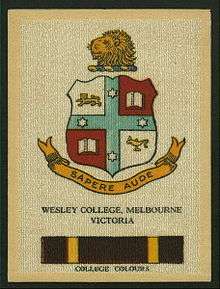
The Wesley College crest appeared in the first edition of the college Chronicle in October 1877.[38] It was designed by Frank Goldstraw, later headmaster from 1893 to 1895.[37] The crest contains a pale blue cross, representing its Wesleyan Methodist Church origins; the Southern Cross; a lion, representing vigilance and constant progress associated with the motto; a book, signifying wisdom to be gained; the bible, recognising the school's Christian association; a lamp, signifying constant light necessary and ready to guide the student in the way of wisdom and a lion's head, asserting that in struggle, royal courage is a ruling element. The motto Sapere Aude was adopted by the school's founders prior to its opening in 1866[39] and is translated from a Latin text by Horace as Dare To Be Wise.
Campuses

Established in 1866,[3] the St Kilda Rd campus has approximately 1,480 students from kindergarten through to Year 12. The Glen Waverley campus, established in 1966, and comprising 59 hectares (146 acres), has approximately 1,420 students from kindergarten through to Year 12. The Elsternwick campus (formerly Methodist Ladies' College and Cato College) has approximately 600 students from kindergarten through to Year 9. The Collins Street campus, established in 1997,[40] caters for the College's city curriculum project.
The Clunes residential campus was established in 1999.[34] Year 9 students spend eight weeks living with other Wesley students in a village. Students are responsible for cooking, cleaning, shopping, washing and undertake activities including voluntary work, art and craft, drama and music.[34]
Wesley has three Outdoor Education sites. Wesley's 130 hectare[41] outdoor education camp at Chum Creek near Healesville commenced in 1952[42] and coincided with the establishment of Timbertop by Geelong Grammar School.[43] The original 200 acres (81 ha) site was donated in 1952 by Alfred Wall, a parent whose family still owns land adjacent to the camp. The remaining 100 acres (40 ha) was purchased in late 1999. Camp Mallana is located on 5 hectares (12 acres) on the Banksia Peninsula, between Bairnsdale and Paynesville, with frontage to Lake Victoria and the Duck Arm shoreline. Camp Lochend, purchased in 1988, is located on 80 hectares (198 acres) near Portland.[41]
Student life
Sport
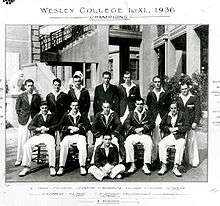
Wesley was one of six founding members of the Associated Public Schools (APS). Lawrence Adamson's tenure as headmaster sparked Wesley's most successful period in APS competition. Between 1901 and 1915, the College captured multiple premierships (first team titles) – rowing (12), football (9), athletics (4) and one for cricket.[44] Since then, notable achievements have been consecutive football premierships between 1959 and 1962, with similar success in cricket between 1933 and 1936, and five cricket titles in six years between 1949 and 1954. Success has largely eluded Wesley in athletics, with only one title since 1911, while the last boys rowing title was in 1984.[44] Wesley has enjoyed greater success in girls sport, particularly in netball, softball and cross country, with over 30 premierships since 1981.[45] Since 2000, Wesley girls have competed against schools from the Associated Grammar Schools of Victoria in addition to APS schools.[45] Wesley has over 120 teams competing in 19 sports from Year 7 to Year 12 level. Sport is compulsory at varying levels for student in Years 7 to 12.[46]
Drama
The St Kilda Road, Glen Waverley and Elsternwick campuses have separate student theatre companies. The Adamson Theatre Company, named after its principal performance venue[47] was established by Tony Conabere at St Kilda Rd campus in 1988.[48] Theatrical performances at Glen Waverley and Elsternwick campuses are both performed under the name Wesley Student Theatre. Various facilities across the campuses are used as well as public venues such as BMW Edge at Federation Square and venues within the Melbourne Arts Centre.[49]
The Glen Waverley campus has performed in New Zealand, Hong Kong, Thailand, Japan, Canada, America, England, Ireland, France, Italy and Germany since 1987.[50]
Music
Glen Waverley & St Kilda Road campuses participate in the Generations In Jazz competition hosted by James Morrison with success achieved by St Kilda Rd (1st in Div 1 1999, 2002, 2004, 2007, 2010 and 2nd in 2008, 2009) and Glen Waverley (2nd in Div 2 2010, 1st in Div 3 2005, 2010).[51]
The College has a long-standing singing tradition, with the first edition of its Wesley College Song Book published in 1893. The fourteenth edition was published in 2009 and over 140 tunes with lyrics have been included in the song book throughout the school's existence.[52] The Wesley College Song Book is traditionally presented to all new students at the commencement of each school year and in turn the Wesley College Gift Book is presented when students leave the College.
Debating
Wesley College participates in the Debaters Association of Victoria (DAV) Schools' Competition[53] and other debating & public speaking tournaments organised by Rotary, the RSL and the United Nations Youth Association of Australia. In 2006, Wesley won the DAV's Schools British Parliamentary debating competition, competing against Scotch College, Sydney Grammar School, and Melbourne Grammar School.
Public Questions Society
The Public Questions Society (PQS) was established at Wesley College in May 1924[54] and was instituted to provide a forum in which contemporary and controversial issues could be discussed. In the 1970s, College Headmaster, Mr David Prest convinced the school council to provide funds to increase the supply of controversial figures to address the college on topics of the hour.[55] Subjects in 1972, for example, included 'Black Power', 'Women's Liberation' and 'Legalisation of Marijuana'.[55] More recent topics have included 'Asian Immigration and the Effect on Australia' and 'The Relationship Between Sport and Academia'. Past speakers have included: Bob Hawke, Dick Hamer, Neale Fraser, Al Grassby, Lou Richards, Keith Dunstan, Ivan Southall,[56] Geoffrey Blainey, Andrew Lemon and Wade Davis.[57]
In 2014, the PQS underwent its most significant change in more than a decade when then PQS Prefect Christopher Reynolds instigated the "Commencement Lecture". The first Commencement Lecture featured the philosopher Peter Singer, who spoke to a crowd of over 500 students and teachers.[58]
Other
The college also offers inter-school activities such as the Tournament of Minds competition, Alliance française competitions, the Duke of Edinburgh Award and other local competitions.
Facilities
Structural
Wesley College and the City of Port Phillip are joint owners of the Albert Park Tennis and Hockey Centre,[59] a facility used by a number of schools, community groups and the general public.
The College's performing arts facilities include keyboard computer music laboratories, music rooms, private music lesson rooms, orchestra rooms, theatres for music, dance and drama, drama and communication studies rooms, performing arts studios, dance studios, recording studios and other recital rooms. Notable halls of Wesley College include Adamson Hall at the St Kilda Road campus (capacity 500), Cato Hall at Glen Waverley campus (700) and Fitchett Hall at Elsternwick (350).[60]
The Coates Pavilion at Glen Waverley was reopened in 2009 following redevelopment.[4] Stage 2 of the 2016 College Sport Facilities master-plan was completed in 2011 when the construction of a new indoor sport complex with associated amenities (including: a weights and conditioning facilities, health and wellbeing centre and staff offices[4]) at the Glen Waverley campus was completed.[61] At the Clunes campus the internal works of the heritage-listed Wesleyan Church were completed in 2010 with new heritage walls, flooring, ceiling and lighting installed; the historic pipe organ was also refurbished and rebuilt.[61]
From 2009 all science laboratories including specialist laboratories at all metropolitan campuses have been progressively redeveloped.[4][61] Further development of sporting and other facilities at both Glen Waverley and St Kilda Rd is planned.[61]
Technology
Wesley was one of the first Australian schools to integrate laptop computers into its curriculum[62] and according to its network provider in 2008, it operated Australia’s largest school notebook PC program.[63] Wesley's IT infrastructure includes over 4,000 notebook, 1,000 desktop computers and 850 network printers.[62] In 2005 wireless internet was launched college-wide.[63] In 2007 Wesley introduced tablet styled notebook computers and was the first educational institution in Australia to do so, but by 2010 were no longer being issued. In 2008, Art students were using Wacom pen-tablets for drawing use.[64] Wesley introduced interactive whiteboards across all classrooms and some lecture theatres in 2008, allowing notes to be printed to a nearby printer or emailed to students.[65] The College also began trialling electronic reading devices in 2008.[66]
Sustainability
In 2008, "green" guidelines were set for staff and students. At Glen Waverley, a desalination plant with four 260,000 litre tanks was installed in 2008 to treat water sourced from a bore originally installed in 1996.[67] It is planned to recycle storm water and run-off irrigation water via storage in 15 additional 110,000 litre tanks to be installed by the end of June 2008.[68] The Glen Waverley campus has 22 worm farms to recycle food scraps.[69] At the St Kilda Road campus, a joint venture with the College's neighbour, Deaf Children Australia, is in place to drill a bore and two 55,000 litre tanks have been installed. At the Elsternwick campus, an artificial turf surface has been installed on the ovals. In maintaining with the College's environmental commitment, the lawn will be a carbon neutral project with additional landscaping to be undertaken around the perimeter to maximize rain catchment.[69] As a result of a successful trial last year using bio-diesel in some of the College's buses, bio-diesel is being implemented for all suitable vehicles across the College.[69] The College's electricity is now supplied from 25% green power sources.[69]
In 2007 the Glen Waverley Junior School became the first independent school in Australia to receive a five-star energy rating from the Australian Government Sustainable Schools Program and by 2008 all campuses had received five-star energy ratings.[70] Sustainability is now part of the College curriculum. In December 2007, Wesley was recognised by Yarra Valley Water in its advertising material for its sustainable water usage, its major water management policy and for reducing its water consumption by 68%.[70]
Wesley College Institute for Innovation in education
The Wesley College Institute for Innovation in Education was launched in 2005.[4] Since 2007, the Wesley College Institute has been working with the Australian Council for Educational Research and the Australian Government's Education Department to develop the Australian Certificate of Education – Vocational. To this end, a pilot vocational program is being considered within the cattle industry in northern Western Australia, as part of the partnership Wesley has with the community at Fitzroy River.[71] The Institute is currently working on a project to establish studio colleges across remote outback Australia.[72] The first studio college is located on Leopold Downs station about 80 km from Fitzroy Crossing.
In April 2010, the Wesley College Institute hosted the 2010 Global Language Convention at Glen Waverley, with delegates attending from 17 universities and over 140 schools.
Notable alumni
Wesley College's alumni include two former prime ministers, twelve Rhodes scholars, five current supreme court judges and 33 Olympic athletes.[1] Among the most notable Old Wesley Collegians are former Australian Prime Ministers Sir Robert Menzies and Harold Holt, cricketers Sam Loxton and Ian Johnson (both members of The Invincibles), and politician, businessman and Olympian Sir Frank Beaurepaire, multiple Olympic and World Championship gold medallist Michael Klim, multiple world champion Emma Carney, tennis player Mark Philippoussis, netballer Sharelle McMahon and multiple knights of the realm.[73]
See List of alumni of Wesley College, Melbourne.
See also
- List of schools in Victoria
- List of high schools in Victoria
- List of largest Victorian Schools
- Victorian Certificate of Education
- International Baccalaureate Organization
Notes and references
- 1 2 "Wesley College Melbourne". Study Link. Retrieved 30 December 2008.
- 1 2 http://emag.allardice.com.au/wesley/collegear2013
- 1 2 3 Lemon, p. 28
- 1 2 3 4 5 "Annual Report 2009". Wesley College, Melbourne.
- ↑ "International Members". HMC Schools. The Headmasters' and Headmistresses' Conference. Retrieved 15 September 2008.
- ↑ Topsfield, Jewel (4 December 2010). "Ties that bind prove a private education has its awards". The Age. p. 11. The hard copy article also published a table of the schools which were ranked in the top ten places, as follows:(1st with 19 awards) Scotch College, Melbourne, (2nd with 17 awards) Geelong Grammar School, (3rd with 13 awards) Sydney Boys High School, (equal 4th with 10 awards each) Fort Street High School, Perth Modern School and St Peter's College, Adelaide, (equal 7th with 9 awards each) Melbourne Grammar School, North Sydney Boys High School and The King's School, Parramatta, (equal 10th with 6 awards each) Launceston Grammar School, Melbourne High School, Wesley College, Melbourne and Xavier College.
- ↑ "Wesley College, Melbourne". Hobsons International Students Guide. Archived from the original on 22 July 2008. Retrieved 27 August 2008.
- 1 2 "Wesley College". School Choice Victoria. Archived from the original on 31 August 2007. Retrieved 15 June 2007.
- ↑ "What We Offer". Wesley College, Melbourne. Archived from the original on 10 June 2008. Retrieved 3 July 2008.
- ↑ "Wesley College (Anti-Discrimination Exemption)(2010)". Victorian Civil and Administrative Tribunal. Retrieved 27 May 2010.
- ↑ "Private school fees break through $20,000". The Age, Melbourne. 30 November 2007. Retrieved 27 August 2008.
- ↑ Lemon, p. 27
- ↑ Blainey et al. p. 21
- ↑ John Martin (2006). "Martin Howy Irving:Professor, Headmaster, Public Servant" (PDF). History of the University Unit, University of Melbourne. p. 21. Retrieved 17 September 2008.
- ↑ Lemon, p. 99
- ↑ "Thomas Palmer (1858–1927)". Australian Dictionary of Biography. Retrieved 28 August 2008.
- ↑ Lemon, p. 54
- 1 2 Lemon, p. 121
- ↑ Lemon, p. 127
- ↑ Blainey et al. p. 150
- ↑ "Alfred and George Nicholas". Australian Dictionary of Biography. Retrieved 5 September 2008.
- ↑ "Inflation calculator". Reserve Bank of Australia.
- ↑ Lemon, pp. 247–248
- ↑ Lemon, pp. 281–283
- ↑ Blainey et al., p. 224
- ↑ Lemon, pp. 288–289
- ↑ Blainey et al., p. 227
- ↑ Lemon, pp. 364 –367
- ↑ "Detailed History: Education and Community Facilities". Monash City Council. Retrieved 28 August 2008.
- ↑ Lemon, pp. 517–520
- ↑ Lemon, pp. 527–537
- ↑ Lemon, p. 542
- ↑ Lemon, pp. 558–560
- 1 2 3 Lloyd, Doug; Downey, Tamara; McDonough, Sharon (2 December 2001). "Annual Conference of the Australian Association for Research in Education (Fremantle, Australia, 2–6 December 2001)". AARE.
|contribution=ignored (help) - ↑ "Woman breaks mould to head Wesley College". The Age, Melbourne. 10 November 2002. Retrieved 27 August 2008.
- ↑ "Fire engulfs building at Wesley College, Glen Waverley". The Age, Melbourne. 20 April 2016. Retrieved 24 April 2016.
- 1 2 Lemon, p. 5
- ↑ Lemon, p. 4
- ↑ Lemon, p. 16
- ↑ Smith, Martyn (September 1997). "Year 9 City Curriculum Pilot Project". Retrieved 2 March 2010.
- 1 2 "Outdoor education". Wesley College. Retrieved 21 September 2010.
- ↑ "Wesley at Chum Creek". National Library of Australia.
- ↑ Lemon, p. 306
- 1 2 "APS Boys Premierships" (PDF). APS Sport.
- 1 2 "APS & AGSV/APS Girls Premierships" (PDF). APS Sport.
- ↑ "A Brief History of Wesley College Sport". Wesley College.
- ↑ "Adamson Theatre Company". Theatre Australia. Retrieved 27 August 2008.
- ↑ "History". Wesley Theatre. Retrieved 31 January 2010.
- ↑ Wesley College: Performing Arts Season 2010 Brochure
- ↑ "Director biography". APAC Theatre. Retrieved 28 August 2008.
- ↑ "Cenerations in Jazz Results". Generations in Jazz Competition – Results. Retrieved 11 June 2011.
- ↑ "Wesley College Songbook". Retrieved 8 June 2011.
- ↑ "Schools Competition". Debaters Association of Victoria.
- ↑ Lemon, p. 391
- 1 2 Lemon, p. 392
- ↑ Lemon, p. 424
- ↑ "PQS". A Cultural Odyssey Enthrals Students. Wesley College, Melbourne. Retrieved 11 June 2011.
- ↑ http://emag.allardice.com.au/wesley/lion/Lion121 page 13
- ↑ "Albert Park Tennis Centre". Retrieved 21 August 2008.
- ↑ "Facility Hire". Wesley College.
- 1 2 3 4 "Annual Report". 2010 Annual Report. Wesley College, Melbourne. Retrieved 11 June 2011.
- 1 2 Wesley College: "Wesley College Technology 2008", pp. 3–4, Wesley College, 2008.
- 1 2 "Case study – Wesley College" (PDF). Cisco Systems. Retrieved 21 July 2008.
- ↑ Wesley College: "Wesley College Technology 2008", p. 5, Wesley College, 2008.
- ↑ Principal's Quarterly Letter to the Wesley College Community, September 2008
- ↑ Wesley College Glen Waverley Campus Newsletter, 2008 – Issue: 27
- ↑ Wotherspoon, Sarah (27 February 2008). "Schools splash out on grounds". Melbourne Herald-Sun. Retrieved 27 August 2008.
- ↑ "Council report – 618-688 High Street Road, Glen Waverley" (PDF). City of Monash. 25 May 2008. Retrieved 27 August 2008.
- 1 2 3 4 Wesley College Glen Waverley Campus Newsletter, 2008 – Issue: 2 (15 February 2008)
- 1 2 "Our Environment". Lion Magazine. Wesley College: 3–7. August 2007.
- ↑ "One language for 'children of different colours'". The Age, Melbourne. 17 November 2005. Retrieved 20 August 2008.
- ↑ "Wesley Lion – Principal's lines". Wesley College. August 2008. Retrieved 17 September 2009.
- ↑ McCallum, David (1 October 1990). The social production of merit: education, psychology, and politics in Australia (1900–1950). Routledge. ISBN 978-1-85000-859-0.
Sources
- Adamson of Wesley: the story of a Great Headmaster Lawrence Arthur Adamson & Felix Meyer (1932) Robertson & Mullens BRN 155
- Wesley College – The First Hundred Years Geoffrey Blainey, James Morrisey and S.E.K. Hulme (1967) Robertson & Mullens
- A Great Australian School: Wesley College Examined Andrew Lemon (2004) Helicon Press ISBN 0-9586785-8-8
- Wesley College Chronicle 2007 Wesley College Community (2007) Wesley College, Melbourne OCLC 748308469
- Lion Magazine August 2007 Edition Wesley College Community (2007) Wesley College, Melbourne
- Cisco Systems Case study – Wesley College Cisco Systems (2007) Cisco Systems Australia Pty. Ltd.
- Wesley College Technology 2008 Wesley College, Melbourne (2008) Wesley College, Melbourne
External links
| Wikimedia Commons has media related to Wesley College, Melbourne. |
- Wesley College, Melbourne Website
- Old Wesley Collegians Association Website
- Wesley College Performing Arts Website
- Wesley College Melbourne – Reflections by Martyn Smith
